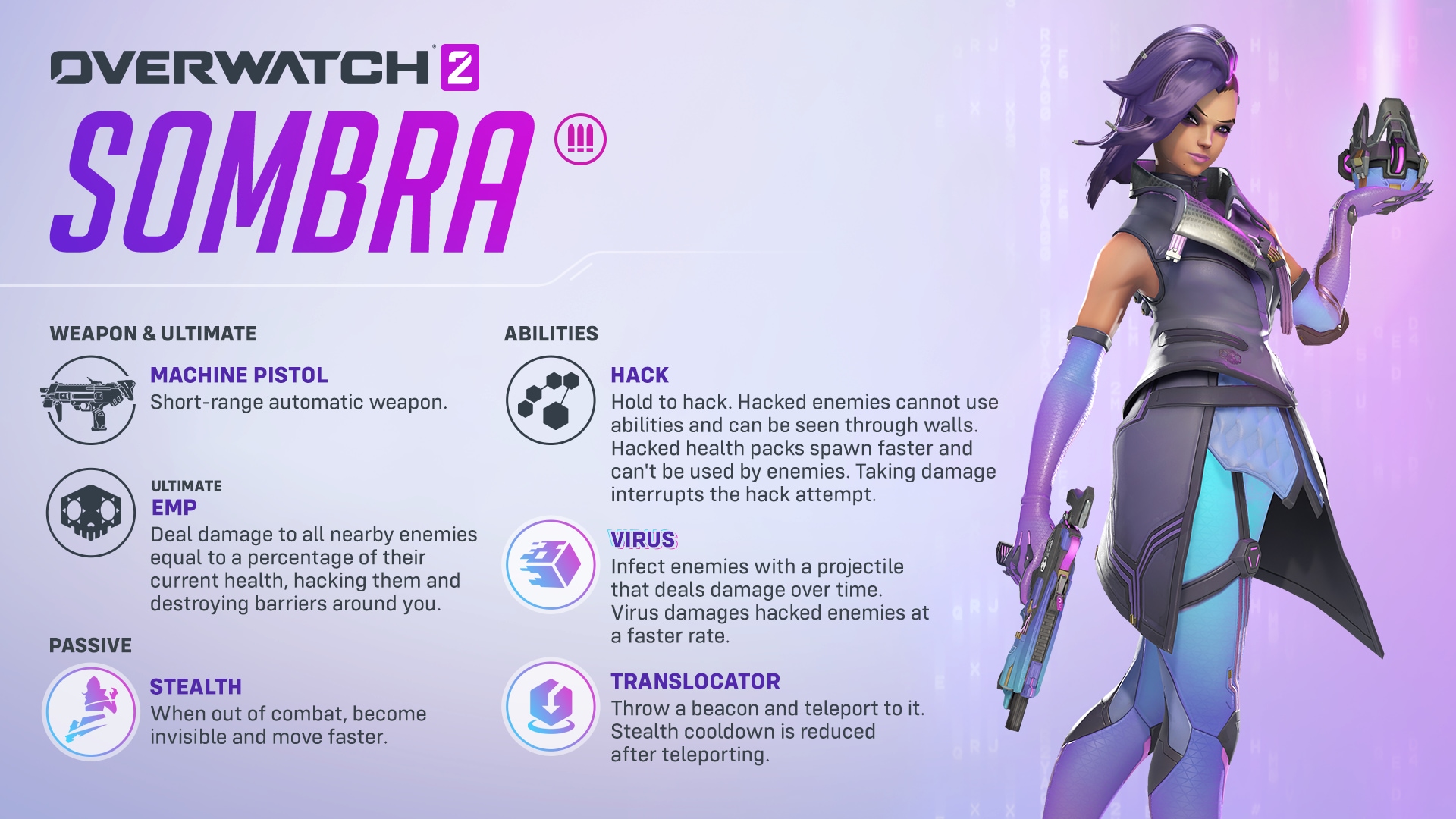
Hola amigos! Andre Abrahamian from the Hero Design Team here subbing in for Aaron this week. I wanted to share with you an in-depth journey through the most recent changes to Sombra, our notorious stealthy hacker. Since her original release in 2016, Sombra has received many changes, including a rework for Overwatch 2's launch. Now the team brings changes to this latest iteration on Sombra once again.
When we look at each Overwatch hero, we are guided by general values to provide a great hero experience. Each hero should have clear strengths and weaknesses that can be tuned accordingly. A hero's impact on a match should be felt by you, your team, and the enemy team. That impact should be clear enough to inform counterplay so that enemies infer how to respond to a particular hero or their abilities. With these points in mind, we felt that Sombra did not have the correct building blocks for her long-term place in the game, and that is what started our latest approach to the rework.
Establishing the Goals
We approached the Sombra Rework by identifying key goals to guide decisions throughout the design iteration process:
- Make Sombra commit to the fight more when engaging.
- Increase the active feel in her ability kit.
- Uphold the current Hacker identity and playstyle.
With these goals, there were multiple angles to tackle around her existing kit. Naturally, many ideas were also meant to address frustrations playing against the character, ensuring there is proper counterplay for the opposing team.
Translocator is a very versatile tool for map traversal and safe escapes. The teleport is often discussed as a “get out of jail free” ability because Sombra can escape as she chooses before enemies can deal a fatal blow. Due to the nature of Overwatch’s fast-paced gameplay, it’s not common to hunt for Sombra’s translocator as a form of counterplay. It's especially difficult to catch Sombra in Overwatch 2 due to the game-wide reduction to stun frequency. There were also common gameplay styles that leave the translocator in safe regions, such as near a health pack, and perform a rinse-and-repeat strategy of solo engaging enemies. While playing a lone wolf can sometimes be viable, we also want to still have moments of active cooperation with nearby allies. When starting our iteration, we tackled each of these aspects for Translocator, wanting to make it more involved in combat.
Stealth is a powerful and unique tool in Sombra’s arsenal, granting invisibility. Naturally, invisibility can be difficult to balance in a competitive multiplayer game. We often discussed certain strengths around the stealth mechanic, such as the capability to Hack while using Stealth, to activate Stealth at any time the cooldown is available, and the infinite duration. We wanted to address each of these concerns during our iterations to see what we can learn from changing them.
Hack is one of the strongest parts of Sombra and has received many changes throughout Overwatch’s history. We discussed this mechanic at great length since this was an opportunity to try new ideas and learn from them. Many different versions of hack were tried throughout the rework, and the most common discussion was about how hack could be used while invisible. We moved ahead with wanting to explore new hack debuff possibilities.
Based on these highlighted aspects of each mentioned ability, we tackled various combinations of changes to find a formula that felt right for Sombra players and all other players. We didn't just want to nerf Sombra though. We wanted to make sure Sombra had more counterplay and could be even more engaging to use. This led to multiple iteration cycles of playtesting and reacting to internal feedback to find the best version of the Sombra rework that we are happy with.
Iteration and Feedback
The early iterations for Sombra started off with rather drastic changes on each ability in order to gain new design insights.
An early idea for changing Hack involved making it no longer silence abilities but instead would deal damage to the enemy if they used any ability. This proved to not be clear enough for enemies to know how they are taking damage, and it did not have consistent output between each usage since it is relying on the enemy player to react. Another iteration was to make enemies deal less damage for a duration. This change struggled because if the damage reduction value was low then it would go unnoticed, and if the value was high then it quickly became oppressive. Other Hack changes were tried but did not stick because of lacking clarity and impact to enemies. We eventually kept the same hack debuff but made hacking an enemy cancel stealth. This worked well because it made Sombra more committed to engaging the enemy and gave the opposing team a consistent opportunity to respond to her.
Translocator had several iterations alongside Stealth, since they are both Sombra’s mobility and escape tools. An early idea was giving translocator a short duration so that it had to be used during combat. We quickly noticed that Sombra players still preferred to try and use their Translocator in safe spots before engaging. We also learned that this change was pushing Sombra’s gameplay style to be closer to team engagements, which we kept in mind with other changes. Stealth had early changes of becoming a dash ability, giving a jolt of movement and a very short duration of unbreakable stealth. While interesting, to have Sombra quickly glimpse in and out of stealth during fights, enemy players were unhappy with no counterplay for unbreakable stealth, and Sombra players wanted more time to flank behind enemy lines.
Eventually, we consolidated the changes to making Translocator a fast teleport and Stealth a passive ability, giving Sombra quicker maneuvers within combat allowing enemies to have more opportunities to react to her. We talked about the Opportunist passive and decided to remove it, making room for the new Stealth passive, while also removing the passive elements of automatically revealing enemies and gaining bonus impact gun damage. We wanted to turn these passive Opportunist elements into something more actively noticable. With this closely combative version of teleporting and stealth, we then started balancing this survivability with some more lethality, which led us to exploring the many possibilities of a new damage ability.
Exploring New Abilities
With the mobility and survivability in a place we felt happy with, we began iterating on new forms of damage. A long list of ideas was explored, ranging anywhere from cybernetic devices to digital malware.
An early idea at the top of the list was a laser wire trap. An idea from her original design, Sombra would place a trap on a wall, and it automatically trigger on nearby enemies to deal damage and slow. Playtests showed that it took too much time preparing the trap, and had little to possibly no effect during combat, so we went back to the drawing board.
Another ability was called “Cybernetic Wire” and would deal damage in an arc, dealing bonus damage to enemies at low health. The intent was to secure kills as a “finishing blow” style ability. This felt too oppressive because of the high amount instant damage that can be dealt to multiple enemies at once, and it was sometimes difficult for Sombra to perceive the physical range in first-person while simultaneously using the machine pistol. Though there were problems, there was excitement around this new form of damage, and we then pivoted to skill shot ability ideas.

Eventually, the ability known today as “Virus” was born as a projectile that deals damage over time. It synergized well with the ranged playstyle, and enemies had more time to respond to the damage over time. We learned that this new form of damage can make Sombra players less likely to hack enemies when engaging out of stealth, so we explored a bonus interaction when Virus impacts hacked targets. Some bonus Virus impact ideas were reducing its cooldown when hitting hacked enemies or spreading the damage to nearby targets. Neither of these felt very clear to enemy players. We settled with the idea of making Virus deal faster damage over time for hacked targets since that had a better balance for enemies to notice and react to the effects.
Once we were happy where this rework was heading, multiple playtests were hosted across the team to collect more feedback and fine-tune the numeric balance. Further playtests helped us tweak changes in the rework, such as making Translocator also reduce the passive Stealth cooldown, giving some extra survivability back to Sombra.
Overall, we finished the rework with the changes you see starting in Season 7: a quick teleport version of Translocator for a more combinative and trackable Sombra, a passive stealth that gives enemies time to react to Sombra before she escapes, and the new Virus ability that gives Sombra more lethality.
SombraMachine Pistol
Hack
Opportunist
Stealth
Virus
Translocator
EMP
|
Moving Forward
We hope this offers more insight into our development process behind hero reworks and our intentions for Sombra’s ability changes. These iterations are focused on making Sombra a more fun and exciting hero to play, and a less frustrating hero to fight against. We feel that this new version of Sombra will provide new combative playstyles and clearer experience for all players. We will continue to watch how Sombra performs going forward and will adjust balance when the time is right. As with all heroes in Overwatch, Sombra is very important to us, and we value the feedback of our amazing community.
Thank you for reading!
Boop!